Maackia 017: An argument against naturalizing your garden
Hi! I’m Nathan Langley and this is Maackia, a monthly newsletter on the perils of naturalized gardening!

I have been on the road again a lot this past month. In particular, I spent some time in Guelph checking in on the property I was stewarding after graduating from the University of Guelph, which I have started managing again remotely from Sudbury. Within this heritage property is a space that I lovingly named “the naturalized area.” I viewed it as an experimental area at the time, where nature would (mostly) be left to its devices. I certainly couldn’t manage the space as a traditional garden by myself. It was just too big (roughly 70 × 30m)! Never mind all the other formal gardens that needed tending to throughout the property and the new garden beds that were being installed on a yearly basis.
When I left Guelph in 2018, the naturalized area was humming along. And by that, I mean it didn't look like a horrible weed patch. At least not to my eyes. I knew what was there, and everything was growing pretty well. Today, it (largely) looks even better! Except for when you want to stroll through the area to enjoy it up close. What I have come to realize after rejoining the project in 2022 is that management is a bit of an issue. Actually, it’s the biggest issue holding the space back from becoming even more enjoyable and beautiful as it continues to mature.
The problem, and my challenge going forward, is that naturalized gardens take a lot of knowledge, physical work, and time to be successful. At this point, I wouldn't recommend installing naturalized gardens to clients if they asked. The second you look away, or don’t keep up, things are likely to go awry in even more frustrating and challenging ways.
The exciting part, however, is figuring out what to do instead.
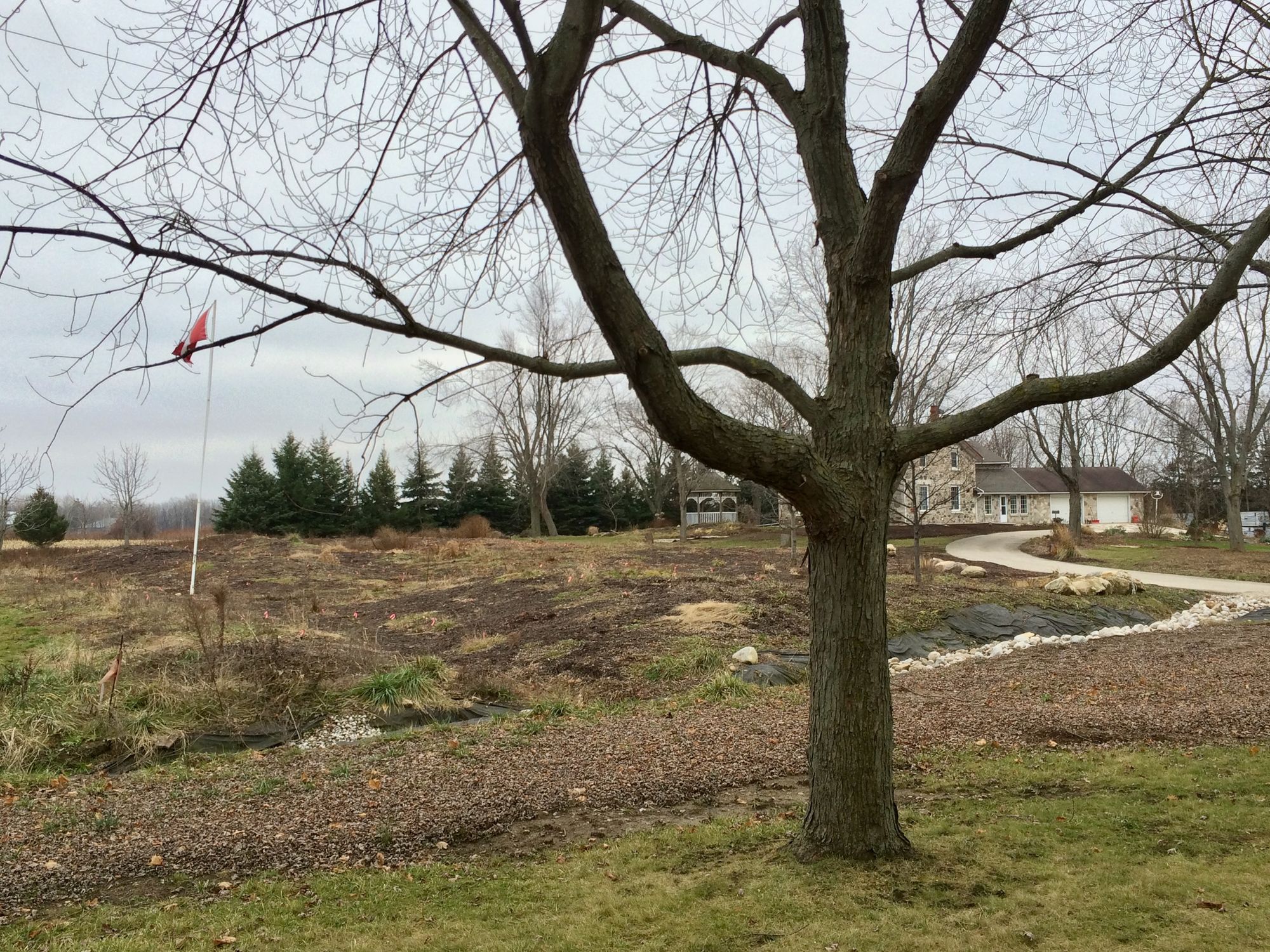
The initial idea for the naturalized area was sound, but the follow through caused numerous issues that took years to straighten out. The area was originally all turf, but was ripped up to install a horizontal geothermal heating / cooling system for the main house. The owner took the initiative to connect with a local conservation authority to field suggestions as to where “naturalized” gardens could be installed on the property. Two areas were identified, the main one being on top of the geothermal system. The owner was already working with a landscape architect on the property, and thus a plan was created in 2014 to plant 7 different tree species in a 2 × 3m grid randomly throughout the space.
New contours (IOW: piles of soil) were created after the geothermal system was installed, and the whole area was topped off with a thick layer of mulch before the trees were installed. The initial tree species chosen for the space and supplied by the conservation authority were:
- red oak
- Kentucky coffee tree
- black cherry
- sugar maple
- chokecherry
- Ohio buckeye
- bur oak
Despite the plan and material used, by 2015 the naturalized area was already in trouble.
To be blunt, of the approximately 230 tree whips that were planted, only half were accounted for when I completed my initial inventory in the early spring months of 2016. Of the trees that were initially planted, most of the fatalities were Kentucky coffee tree and bur oak.
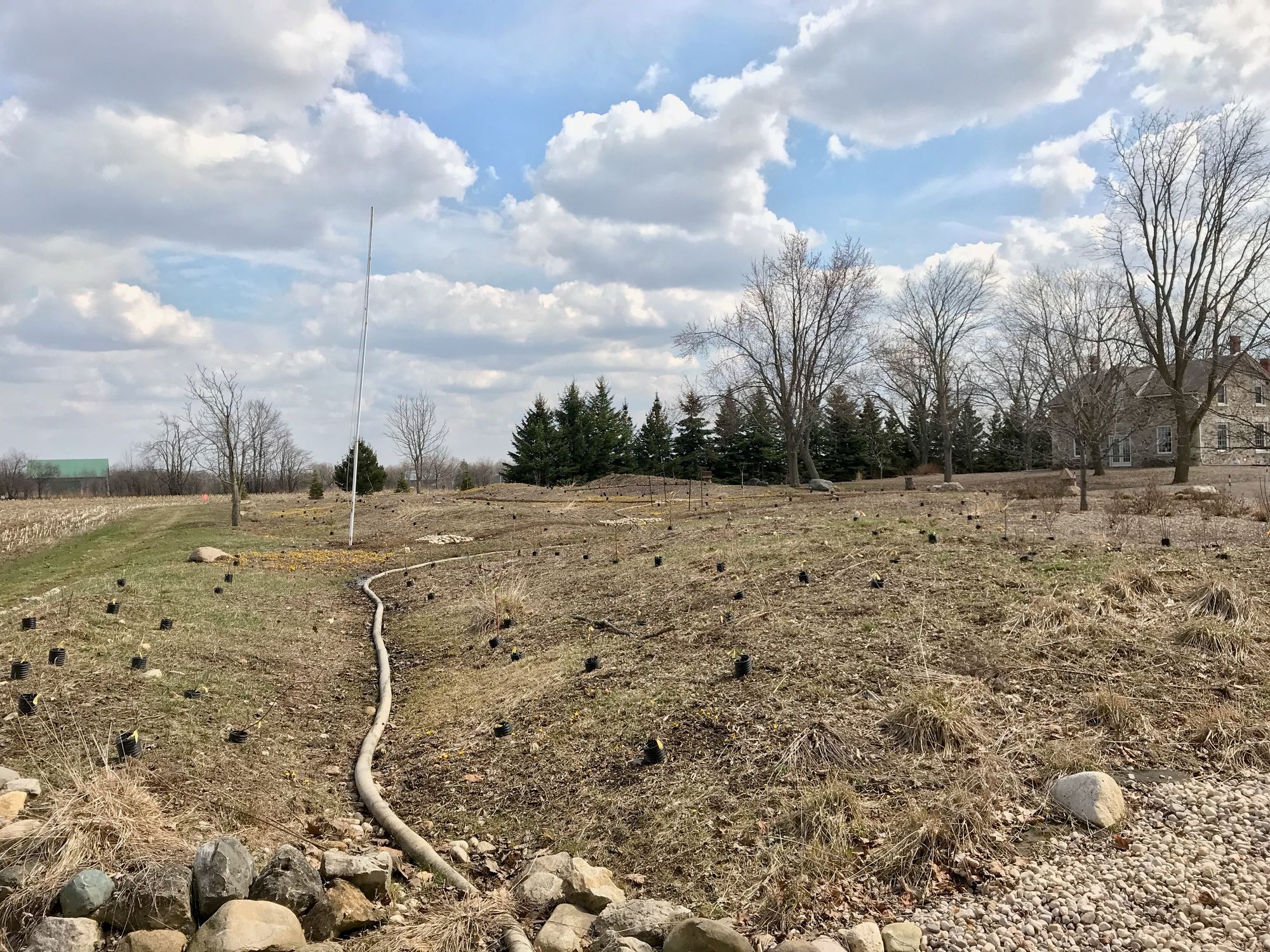
There wasn’t a singular cause for all the deaths, but one thing was perfectly clear: I needed to tackle what was going on with the ground layer before I could really worry about the trees. First, I created a natural draining point for surface water using the contours that were already present. There was just too much standing water in certain areas, and because the trees were planted randomly and weren’t species that adapt well to having wet feet, a lot of the specimens died as a result.
I also added one new feature: a small, narrow pathway. Even though I had been on-site for less than a year, I was constantly being asked when I was going to cultivate the “weed patch.” My advisor at Guelph taught me about the idea of “cues to care” within landscaped areas (basically, we like to see hints that an area is being actively looked after and cared for). I wanted to take that concept and apply it to the naturalized area by enticing people to walk into and throughout the space. Then they might discover the more delicate and detailed beauty of a natural garden and all the work that goes into managing it.
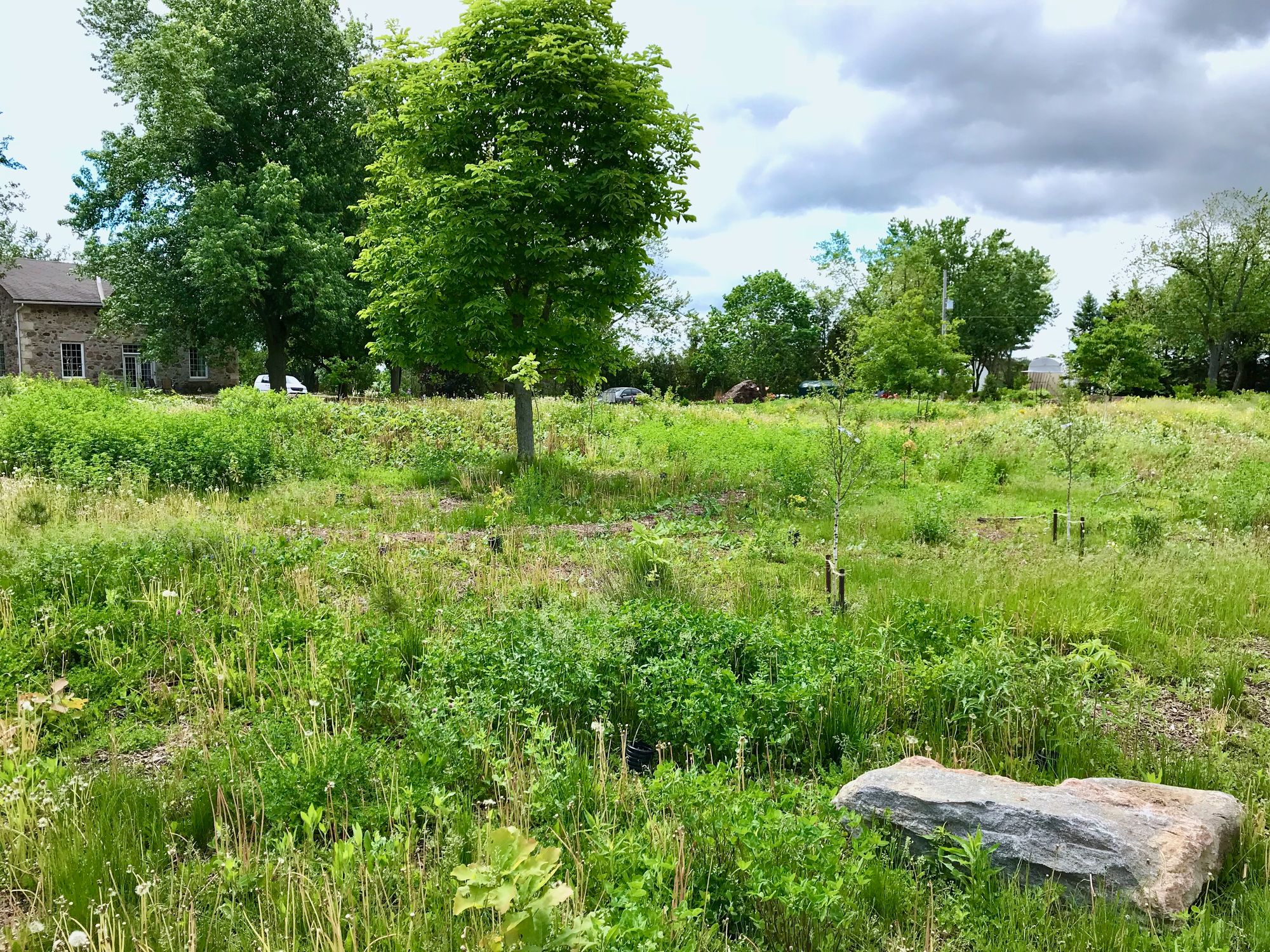
While I was still struggling with invasive species blowing in and colonizing parts of the naturalized area (among other things), I was making steady progress getting the space growing in a positive direction. By my final season in 2018, I had added numerous woody tree / shrub species to the mix:
- Eastern white pine
- white spruce
- black maple
- musclewood
- hackberry
- red maple
- pin oak
- swamp white oak
- larch
- paper birch
- grey birch
- redbud
- bladdernut
- red-osier dogwood
- roundleaf dogwood
- alternate-leaf dogwood
- serviceberry
- chokeberry
- nannyberry
I also incorporated a few different native seed perennial mixes from OSC to try to compete with all the volunteer seeds that were in the soil already or were being blown in from surrounding properties. While I wasn’t able to see the fruits of my work at the time when I left, I trusted that nature would find its way and hoped that things would be ok down the road.
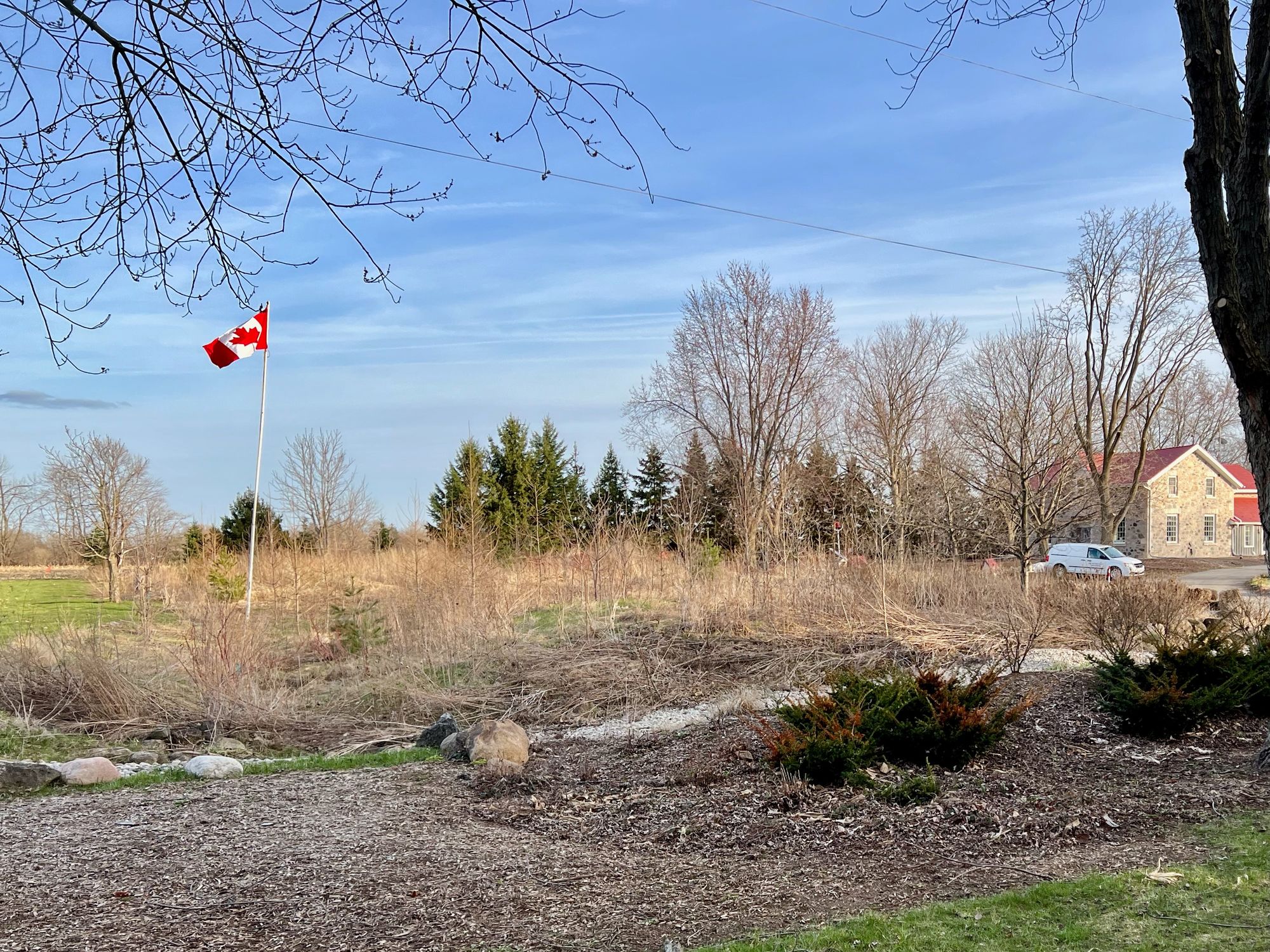
Which leads me to today and the headaches with naturalized gardens. A lot of my experiments worked (yay!), but they, in turn, have lead to more issues.
The first issue is a basic one: knowledge. To proactively manage an area like this with all the different plant species, you need to know what you are looking at. Even more so, you need to have working knowledge of both the plants you want to grow and the ones you don’t. Adding more woody species and various perennial seed mixes to the naturalized area complicated matters on the ground immensely. You also have to know how to remove the invasive plants so that they don’t continue to spread (hint: cutting them at the base and leaving them to decompose on their own is not the answer). And you must know how to diagnose health issues with each plant, so you can better steer the garden in a direction where it will thrive. In my experience, this is already too much of an ask for 9/10 people within their residential properties.
The second issue is the amount of physical work that is required to maintain a garden like this. The good news is that it is less annoying than mowing your lawn every week (at least I find it less annoying; YMMV). But it still requires hard, physical work on a semi-regular basis. You typically have to wade through chest-high plants to get to something that you want to tackle. I hope you don’t mind being touched constantly by plants, and the occasional bug (or two, or three). Did I mention spider webs? There are a lot of spider webs. Again, I don’t mind this, but I have a feeling most of my residential clients might.
The third issue is time. It takes a lot of time to see a garden like this come into its own. Unlike traditional cultivated gardens that are held in stasis once they mature, these gardens don’t stop changing. Plants are constantly competing with one another, with predators, and with the elements. Change is to be expected, whether you want it or not. Also, NIMBYism. You can definitely count on NIMBYism, whether you want it or not (sometimes neighbours don't want to wait 5 or 10 years for your natural garden to "look good" 😫). Seeing things through a neighbours eyes makes sense when you try it – they just see a giant weed patch. But boy is that ever frustrating to hear after so much hard work!
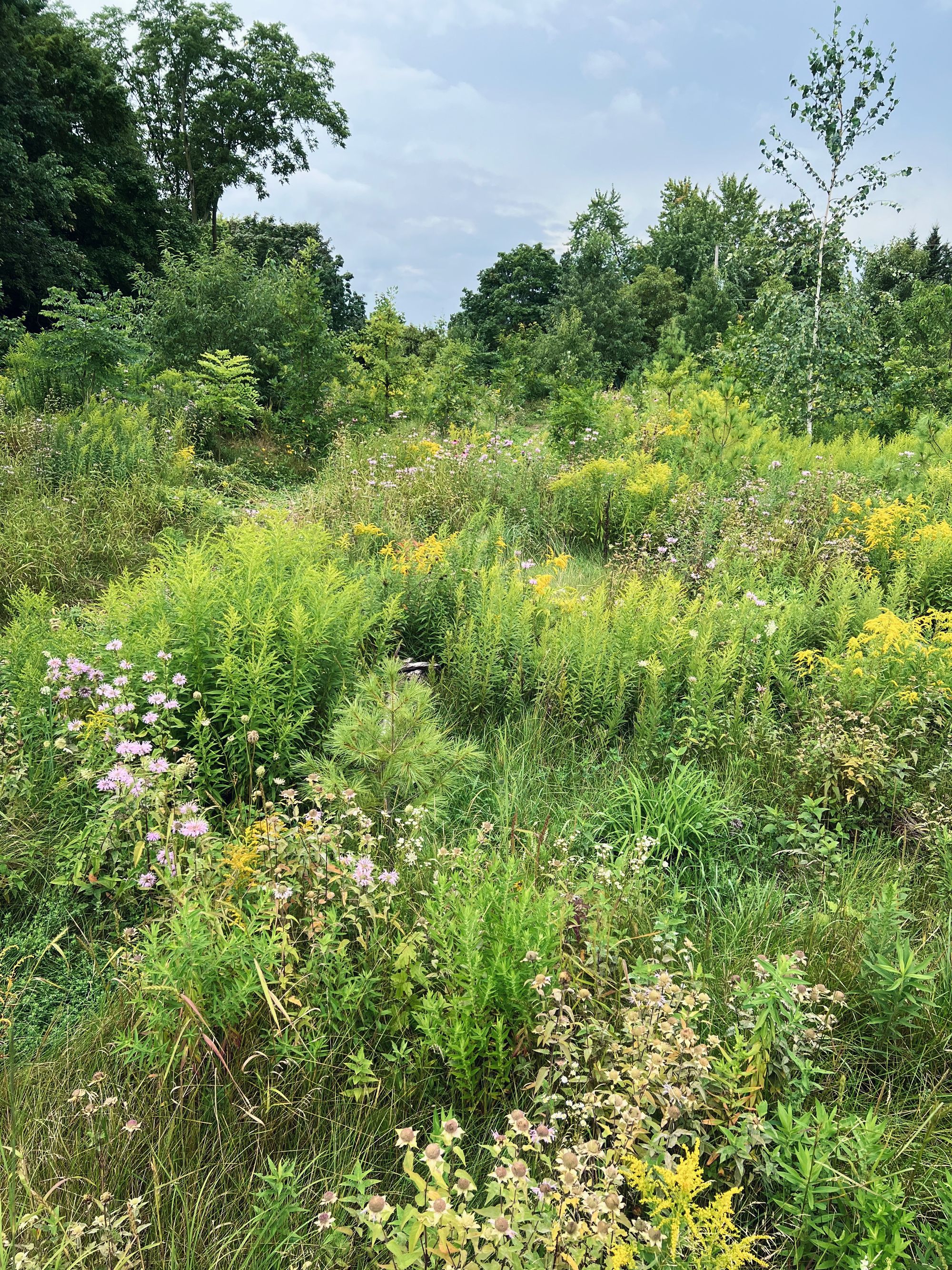
Despite these three issues, I am hopeful that a more natural “style” of gardening will take root and flourish in the years ahead. I don’t like endless lawns with a token street tree and one or two foundation garden beds. Our neighbourhoods could be so much more than that, and I don’t think it would take more energy or expense than what is already spent maintaining lawns and buying annuals!
But I don’t think truly natural gardens are the answer either (at least, not yet). The ask is just too big. The "cues to care" aren't obvious enough. I don’t even think most municipalities could actively manage large scale natural gardens. A lot of them have a hard enough time managing their street trees.
I guess my underlying hopefulness is what drew me to Piet Oudolf in the first place. He wasn’t selling his gardens as being natural. They are “inspired” by nature. It is a subtle but important difference and is similar to a line of thinking I was taught during my time at the UBC Botanical Garden. But even Oudolf's gardens have the same problems that I outlined above. It keeps coming back to maintenance. You can have the best laid out and creative planting plan in the world, but if you don’t maintain it, it will look horrible within a few years.
The let down, at this point, is that I don’t have an answer to my problem to share with you. How could I? So much of it is outside the scope of my current work. My only suggestion is that you pause and really think about all the ins and outs if you want to add a more natural style to your home garden. Work on your plant knowledge and understand the amount of energy it will take to embrace a natural garden. And most of all, be patient with yourself, the plants, and your neighbours (as hard as that can be sometimes).
In the end, though, I am excited by the challenge ahead. It gives me something to work on through the years to see if I can actually come up with a feasible solution for the area I am in. Something replicatable that can be done at scale – that's where a sizeable impact can be made.
I really couldn’t ask for more. I just need to actually get around to creating a trial garden at home first. 😓
n